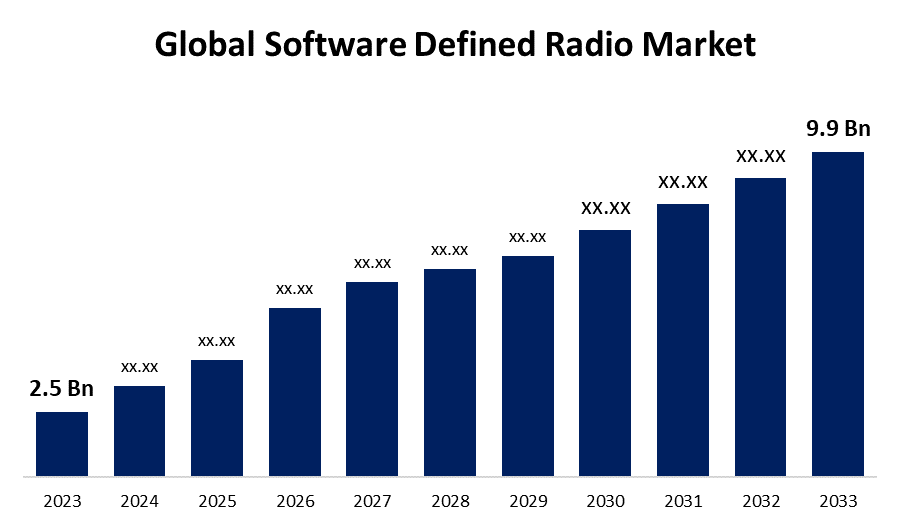Global Software Defined Radio Market Size, Share, and COVID-19 Impact Analysis, By Type (General Purpose Radio, Joint Tactical Radio System, Cognitive Radio, TETRA), By Component (Hardware, Software), By Platform (Ground, Naval), and By Region (North America, Europe, Asia-Pacific, Latin America, Middle East, and Africa), Analysis and Forecast 2023 - 2033
Industry: Aerospace & DefenseGlobal Software Defined Radio Market Insights Forecasts to 2033
- The Software Defined Radio Market Size was valued at USD 2.5 Billion in 2023.
- The Market Size is growing at a CAGR of 14.75% from 2023 to 2033.
- The Worldwild Software Defined Radio Market is expected to reach USD 9.9 Billion by 2033.
- Asia Pacific is expected to grow the fastest during the forecast period.

Get more details on this report -
The Global Software Defined Radio Market Size is expected to reach USD 9.9 Billion by 2033, at a CAGR of 14.75% during the forecast period 2023 to 2033.
The Software Defined Radio (SDR) market is experiencing significant growth, driven by increasing demand for flexible and interoperable communication systems across defense, aerospace, telecommunications, and public safety sectors. SDR technology enables dynamic reconfiguration of radio functions through software, reducing hardware dependencies and improving adaptability. The rising adoption of SDRs in military applications for secure communication, along with advancements in cognitive radio and AI integration, is fueling market expansion. Additionally, the proliferation of 5G networks and IoT connectivity is further driving demand. North America leads the market due to high defense investments, while Asia-Pacific is witnessing rapid growth due to expanding telecom infrastructure. Challenges include high initial costs and cybersecurity risks, but ongoing technological advancements and regulatory support are expected to boost market adoption.
Software Defined Radio Market Value Chain Analysis
The Software Defined Radio (SDR) market value chain comprises multiple stages, from component suppliers to end-users. It begins with raw material and component suppliers, providing essential hardware like processors, FPGAs, RF front-ends, and antennas. Next, SDR manufacturers and developers integrate these components with software-defined capabilities, ensuring flexibility and performance. Software providers play a crucial role by developing waveforms, protocols, and security solutions for seamless operation. System integrators then customize SDR solutions for industries like defense, telecommunications, and public safety. Distributors and service providers ensure market reach, offering deployment, maintenance, and upgrades. Finally, end-users such as military agencies, telecom operators, and emergency services utilize SDRs for secure and adaptive communication. Continuous innovation and regulatory compliance shape this evolving value chain.
Software Defined Radio Market Opportunity Analysis
The Software Defined Radio (SDR) market presents significant growth opportunities driven by advancements in wireless communication, defense modernization, and the expansion of 5G and IoT networks. The increasing need for secure, flexible, and interoperable communication systems in military and public safety sectors is fueling demand. Emerging markets, particularly in Asia-Pacific, offer opportunities due to rising defense budgets and telecom infrastructure expansion. The integration of AI and machine learning in SDRs enhances spectrum efficiency and cognitive radio capabilities, opening new possibilities. Additionally, commercial applications such as satellite communication, autonomous vehicles, and smart grid networks are expanding SDR adoption. Despite challenges like high initial costs and cybersecurity risks, ongoing technological developments and regulatory support are expected to drive sustained market growth.
Global Software Defined Radio Market Report Coverage
| Report Coverage | Details |
|---|---|
| Base Year: | 2023 |
| Market Size in 2023: | USD 2.5 Billion |
| Forecast Period: | 2023 – 2033 |
| Forecast Period CAGR 2023 – 2033 : | 14.75% |
| 023 – 2033 Value Projection: | USD 9.9 Billion |
| Historical Data for: | 2019-2022 |
| No. of Pages: | 240 |
| Tables, Charts & Figures: | 110 |
| Segments covered: | By Type, By Component, By Platform and By Region |
| Companies covered:: | BAE Systems (US) L3Harris Technologies, Inc (US) Northrop Grumman Corporation (US) Thales (France) Elbit Systems Ltd. (Israel) General Dynamics Corporation (US) Raytheon Technologies Corporation (US) Leonardo Company |
| Pitfalls & Challenges: | COVID-19 Empact,Challenges, Future, Growth, & Analysis |
Get more details on this report -
Market Dynamics
Software Defined Radio Market Dynamics
The fast-paced advancement of wireless communication technologies.
The fast-paced advancement of wireless communication technologies is a key driver of growth in the Software Defined Radio (SDR) market. Increasing demand for flexible, reconfigurable, and software-driven communication systems is accelerating SDR adoption across defense, telecommunications, and public safety sectors. The expansion of 5G networks, IoT connectivity, and satellite communications further enhances market opportunities. SDRs enable seamless interoperability, spectrum efficiency, and secure transmission, making them essential for modern communication infrastructure. Emerging technologies like AI-driven cognitive radios and cloud-based SDR solutions are also transforming the industry. Additionally, rising defense investments and the need for secure tactical communications are fueling market expansion. While challenges such as cybersecurity risks and high deployment costs exist, ongoing innovations and supportive regulations are expected to drive continuous SDR market growth.
Restraints and Challenges
The Software Defined Radio (SDR) market faces several challenges despite its growing adoption. High initial costs for development, deployment, and maintenance pose a significant barrier, particularly for small and medium-sized enterprises. Cybersecurity threats are another major concern, as SDRs rely on software-based processing, making them vulnerable to hacking and signal interference. Complexity in integration with existing communication infrastructure and legacy systems can slow adoption. Additionally, regulatory and spectrum allocation challenges create hurdles in deploying SDRs across different regions. The need for highly skilled professionals to manage SDR systems adds to operational challenges. Moreover, power consumption and latency issues in real-time applications can impact performance. Addressing these challenges through continuous technological advancements and regulatory support will be crucial for sustained SDR market growth.
Regional Forecasts
North America Market Statistics

Get more details on this report -
North America is anticipated to dominate the Software Defined Radio Market from 2023 to 2033. The U.S. leads the region due to high military spending on secure and flexible communication systems for tactical operations. The growing adoption of SDRs in public safety, aerospace, and commercial applications further strengthens market growth. The expansion of 5G networks and IoT connectivity also boosts demand for SDR technology in telecom and enterprise sectors. Additionally, research and development initiatives by key industry players and government agencies, such as the Department of Defense and NASA, contribute to continuous advancements. However, challenges such as cybersecurity risks and regulatory complexities remain. Despite this, ongoing investments and technological progress are expected to sustain North America's SDR market leadership.
Asia Pacific Market Statistics
Asia Pacific is witnessing the fastest market growth between 2023 to 2033. China, India, Japan, and South Korea are heavily investing in SDRs for military modernization, secure tactical communication, and public safety applications. The rise of 5G deployment and IoT adoption further accelerates SDR demand in commercial sectors. Additionally, growing research initiatives and government support for indigenous SDR development enhance market opportunities. However, challenges such as regulatory compliance, spectrum allocation issues, and cybersecurity risks persist. Despite these hurdles, Asia-Pacific remains a high-potential market, with continuous investments in defense, telecom, and aerospace expected to drive long-term SDR adoption and technological advancements in the region.
Segmentation Analysis
Insights by Component
The hardware segment accounted for the largest market share over the forecast period 2023 to 2033. Key components such as field-programmable gate arrays (FPGAs), digital signal processors (DSPs), RF front-ends, and antennas are evolving to support higher frequencies and bandwidths. The rising adoption of SDRs in defense, aerospace, and commercial applications, including 5G networks and IoT, is further fueling hardware demand. Additionally, innovations in AI and machine learning are enhancing SDR hardware efficiency and adaptability. However, challenges like high development costs and power consumption persist. Despite this, continuous technological advancements and increasing investments in next-generation SDR platforms are expected to drive sustained growth in the hardware segment.
Insights by Type
The joint tactical radio system segment accounted for the largest market share over the forecast period 2023 to 2033. JTRS enables secure, flexible, and interoperable communications for defense forces, allowing them to adapt to dynamic battlefield environments. With increasing investments in defense and security, particularly by the U.S. Department of Defense, the demand for JTRS-equipped SDR solutions is rising. The ability to integrate various communication systems and support multiple frequency bands enhances the operational efficiency of military operations. Additionally, advancements in cognitive radio technologies and spectrum management are boosting the performance of JTRS. Despite challenges related to high costs and complex integration with legacy systems, the growing focus on modernizing military communications is expected to drive continued expansion in the JTRS segment.
Insights by Platform
The ground segment accounted for the largest market share over the forecast period 2023 to 2033. Ground-based SDR systems are essential for applications like satellite communication, border surveillance, and public safety. The need for high-performance, adaptable radio solutions that can operate across various frequency bands and environments is accelerating market adoption. Additionally, the integration of SDRs in ground stations for 5G networks, IoT infrastructure, and disaster response is expanding their use. Innovations in cognitive radio and spectrum efficiency further enhance the capabilities of ground-based SDR systems. Challenges such as high initial costs and integration with existing communication infrastructure persist but are mitigated by ongoing advancements and government investments, particularly in defense and emergency services.
Recent Market Developments
- In October 2024, The U.S. Army awarded BAE Systems plc a contract valued at up to USD 460 million to deliver multi-mode aviation radio sets, crucial for improving communication capabilities in military operations.
Competitive Landscape
Major players in the market
- BAE Systems (US)
- L3Harris Technologies, Inc (US)
- Northrop Grumman Corporation (US)
- Thales (France)
- Elbit Systems Ltd. (Israel)
- General Dynamics Corporation (US)
- Raytheon Technologies Corporation (US)
- Leonardo Company
Market Segmentation
This study forecasts revenue at global, regional, and country levels from 2023 to 2033.
Software Defined Radio Market, Type Analysis
- General Purpose Radio
- Joint Tactical Radio System
- Cognitive Radio
- TETRA
Software Defined Radio Market, Component Analysis
- Hardware
- Software
Software Defined Radio Market, Platform Analysis
- Ground
- Naval
Software Defined Radio Market, Regional Analysis
- North America
- US
- Canada
- Mexico
- Europe
- Germany
- Uk
- France
- Italy
- Spain
- Russia
- Rest of Europe
- Asia Pacific
- China
- Japan
- India
- South Korea
- Australia
- Rest of Asia Pacific
- South America
- Brazil
- Argentina
- Rest of South America
- Middle East and Africa
- UAE
- Saudi Arabia
- Qatar
- South Africa
- Rest of the Middle East and Africa
Frequently Asked Questions (FAQ)
-
1. What is the market size of the Software Defined Radio Market?The global Software Defined Radio Market is expected to grow from USD 2.5 billion in 2023 to USD 9.9 billion by 2033, at a CAGR of 14.75% during the forecast period 2023-2033.
-
2. Who are the key market players of the Software Defined Radio Market?Some of the key market players of the market are BAE Systems (US),L3Harris Technologies, Inc (US),Northrop Grumman Corporation (US),Thales (France), Elbit Systems Ltd. (Israel),General Dynamics Corporation (US),Raytheon Technologies Corporation (US), Leonardo Company.
-
3. Which segment holds the largest market share?The ground segment holds the largest market share and is going to continue its dominance.
-
4. Which region dominates the Software Defined Radio Market?North America dominates the Software Defined Radio Market and has the highest market share.
Need help to buy this report?